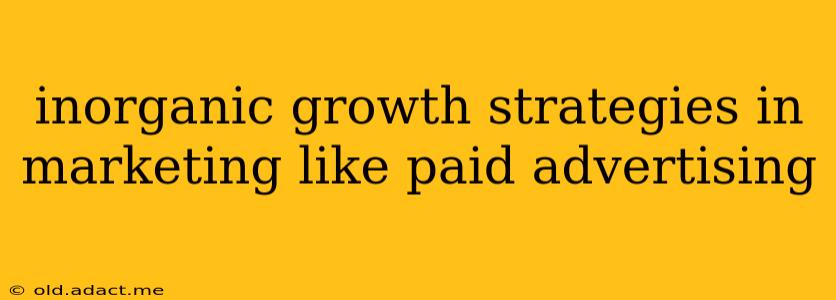In the dynamic world of marketing, growth is paramount. While organic strategies like SEO and content marketing lay the foundation, inorganic growth strategies provide the rocket fuel for rapid expansion. This post delves into the world of inorganic growth, focusing particularly on paid advertising, and exploring other effective tactics to boost your brand visibility and market share.
What are Inorganic Growth Strategies?
Inorganic growth, in contrast to organic growth (which relies on internal efforts), involves acquiring external resources to accelerate expansion. In marketing, this translates to strategies that leverage paid channels or partnerships to reach a wider audience and achieve quicker results. It's about investing resources to stimulate growth, rather than relying solely on organic methods.
The Power of Paid Advertising: A Deep Dive
Paid advertising, a cornerstone of inorganic growth, encompasses various channels, each with its own strengths:
1. Search Engine Marketing (SEM): Google Ads and Beyond
SEM, primarily through platforms like Google Ads, allows you to place your ads prominently in search engine results pages (SERPs). By targeting specific keywords, you can reach users actively searching for products or services relevant to your business. Effective keyword research and meticulous ad copy are crucial for maximizing your return on investment (ROI).
2. Social Media Advertising:
Platforms like Facebook, Instagram, Twitter, and LinkedIn offer robust advertising options, allowing hyper-targeted campaigns based on demographics, interests, behaviors, and even custom audiences. Visual content is key here, making compelling images and videos essential for capturing attention.
3. Programmatic Advertising:
Programmatic advertising uses sophisticated algorithms to automate ad buying and placement across multiple platforms. This allows for highly targeted campaigns with real-time optimization, ensuring your ads reach the most relevant audience.
4. Display Advertising:
Display ads appear on websites and apps through banner ads, video ads, and other formats. Strategic placement and creative design are paramount to capture user attention without being intrusive.
5. Influencer Marketing:
Partnering with influential individuals in your niche can significantly expand your reach. Influencers can authentically promote your brand to their engaged followers, building trust and credibility. However, careful selection of influencers is critical to align with your brand values and target audience.
Other Key Inorganic Growth Strategies
Beyond paid advertising, other inorganic methods can significantly contribute to your growth trajectory:
Strategic Partnerships & Joint Ventures:
Collaborating with complementary businesses can introduce your brand to a new audience, leveraging the established reach and credibility of your partners. Joint promotions, cross-promotional campaigns, and shared resources are effective strategies here.
Public Relations (PR):
Building positive media coverage through press releases, media outreach, and building relationships with journalists and bloggers can establish your brand's authority and increase its visibility. Positive PR generates earned media, boosting your brand's reputation and credibility.
Acquisitions:
Acquiring a smaller, complementary company can quickly expand your market share, product line, or customer base. However, this strategy requires significant investment and careful due diligence.
Frequently Asked Questions (FAQs)
How do I measure the success of my inorganic growth strategies?
Measuring success involves tracking key performance indicators (KPIs) such as website traffic, leads generated, conversion rates, return on ad spend (ROAS), and brand awareness metrics. Analytics platforms and marketing attribution tools provide the data you need to optimize your campaigns.
What's the difference between organic and inorganic growth?
Organic growth relies on internal efforts like SEO and content marketing, building a brand's presence naturally over time. Inorganic growth uses external resources like paid advertising and acquisitions to accelerate expansion.
Which inorganic strategy is best for my business?
The ideal strategy depends on your specific goals, target audience, budget, and industry. A well-defined marketing plan incorporating a mix of inorganic strategies tailored to your business is often the most effective approach.
How can I avoid wasting money on inorganic growth strategies?
Thorough planning, targeted campaigns, ongoing monitoring, and consistent optimization are essential for maximizing your ROI. A/B testing different approaches and constantly analyzing your data will prevent wasted resources.
In conclusion, inorganic growth strategies, particularly paid advertising, are powerful tools for accelerating your marketing efforts. However, they require a strategic approach, careful planning, and ongoing optimization to ensure a positive return on your investment. By strategically blending inorganic strategies with your organic initiatives, you can build a robust and effective growth engine for your business.
